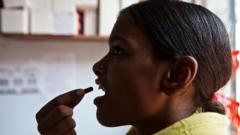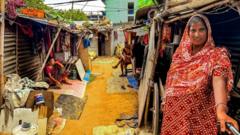India is struggling with a dual crisis of antibiotic overuse and limited access to life-saving drugs, resulting in a significant number of deaths from treatable infections. A recent study highlights the urgent need for enhanced healthcare systems and improved access to antibiotics to combat the rising threat of antimicrobial resistance.
Struggle Against Superbugs: India Faces Crisis Amidst Antibiotic Access Challenges

Struggle Against Superbugs: India Faces Crisis Amidst Antibiotic Access Challenges
A study reveals the grim reality of inadequate antibiotic access in India, with deadly superbugs on the rise due to both overuse and scarcity of effective treatments.
India is facing a daunting challenge in its battle against antibiotic-resistant infections as access to crucial medications declines. A recent analysis conducted by the Global Antibiotic Research and Development Partnership (GARDP) has unveiled that while antibiotics are being overused, many patients suffering from serious infections stemming from carbapenem-resistant Gram-negative (CRGN) bacteria cannot acquire the necessary treatments.
The study reviewed cases of CRGN infections in various low- and middle-income nations, including India, which accounted for a significant proportion of these infections. Alarmingly, only 6.9% of patients received the appropriate treatment needed to combat these superbugs. Despite India procuring 80% of the studied antibiotics, the country managed to treat a mere 7.8% of the estimated cases. These resistant strains cause various infections like urinary tract infections and pneumonia, which can be particularly perilous for vulnerable populations such as newborns and the elderly.
Dr. Abdul Gaffar, an infectious disease consultant in Chennai, remarked on the tragic irony of the situation; even with antibiotics available, patients are succumbing to infections that could be treated. Experts indicate that while there is a strong narrative around the overuse of antibiotics globally, the reality in poorer nations shows that a lack of access leads to needless deaths from treatable infections.
The research highlighted a significant gap in the availability of effective antibiotics, with only eight intravenous drugs active against CRGN bacterial infections being reviewed. Shortages and cost barriers prevent many patients from receiving the essential medications, often leading doctors to face frustrated patients resistant to treatment. Dr. Cohn from GARDP emphasized the need for systemic changes to ensure equitable access while preventing misuse by wealthier individuals.
To address these critical challenges, reforms are essential. Advocates suggest the enforcement of regulatory measures, such as requiring secondary sign-offs from specialists for antibiotic prescriptions. Access to these medications must be enhanced, and cost-effective procurement methods should be explored to ensure that patients receive appropriate treatment for their infections.
Amidst these obstacles, India may possess crucial capabilities to tackle antimicrobial resistance effectively. With its strong pharmaceutical sector, the country could play a vital role in advocating for the necessary drug developments while simultaneously generating local data that identifies care gaps.
Ultimately, the situation underscores the urgent need for a coordinated response to tackle the rising tide of antibiotic resistance, which threatens not only the treatment of infections but the very foundations of modern healthcare. As Dr. Gaffar points out, it’s vital to ensure that the right antibiotics reach those who need them most while saving newer drugs for appropriate cases, emphasizing that effective antibiotic stewardship and access are both fundamental to overcoming this crisis.






















